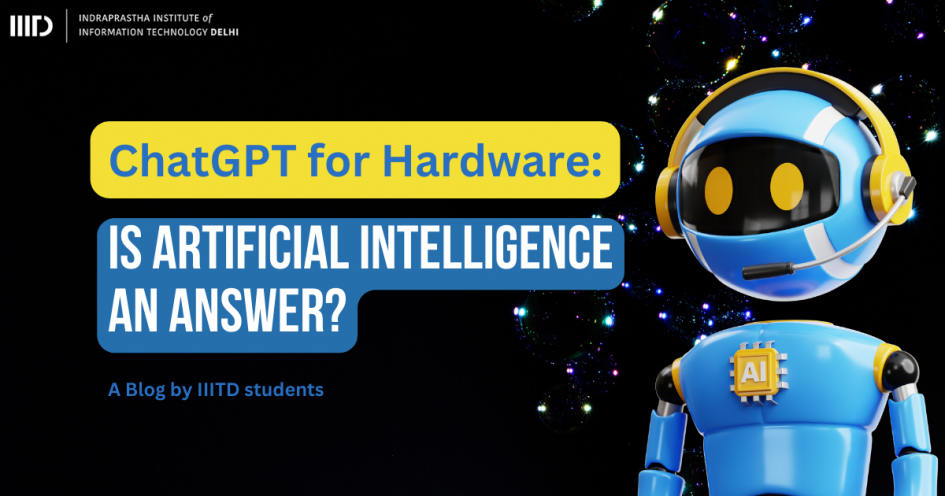The evolution of Chat Generative Pre-Trained Transformer (ChatGPT), an artificial intelligence (AI) chatbot, has profoundly influenced our communication, learning, and exploration of the unknown. Numerous studies and news articles have discussed the repercussions of ChatGPT on the efficacy of academic take-home assignments and projects. Computer engineering and humanities fields have particularly experienced notable challenges due to ChatGPT, leading to some universities imposing bans on its use by students. This blog delves into exciting insights on the effectiveness of ChatGPT for hardware courses in the VLSI domain.
In August-November 2023, Indraprastha Institute of Information Technology Delhi (IIIT-Delhi) offered the ECE270: Embedded Logic Design (ELD) course to approximately 120 second-year undergraduate students. This course specifically focuses on the design of digital hardware circuits and embedded systems on a system-on-chip (SoC). Like other programming courses, ELD includes weekly hardware labs programmed using Verilog, a hardware description language (HDL) and C/C++. This year, students could utilize ChatGPT in lab homework and exams. The subsequent discussion sheds light on the students’ experiences regarding the efficacy of ChatGPT in the context of hardware labs.
ChatGPT proved exceptionally valuable for generating Verilog and C/C++ code for a given requirement. In numerous instances, the produced codes exhibited efficiency suitable for hardware implementation, allowing students to streamline their search time. Moreover, ChatGPT demonstrated its versatility by crafting test benches, which is crucial for testing circuit functionality through simulations. Many students leveraged ChatGPT to deepen their understanding of various Verilog concepts and existing codes, finding it a practical companion that provided comprehensive explanations. As a result, ChatGPT minimized reliance on Teaching Assistants and functioned as a readily available 24×7 assistant throughout the learning process.

In contrast to software programming, which predominantly revolves around writing code, hardware labs encompass a broader scope beyond coding. With that, the true challenge for ChatGPT arises, especially with a system design that entails multiple hardware blocks and algorithm-to-architecture mapping on the hardware platform. This needs a good understanding of VLSI tools, hardware platforms, and integration of multiple hardware blocks. For instance, while ChatGPT can readily generate Verilog code for a 3-bit full adder, it encounters difficulties when tasked with writing code for implementing a 3-bit full adder operating at 1 Hz. This challenge arises due to the necessity for integrating multiple hardware blocks. Therefore, the complexity of system design on hardware platforms requires the augmentation of AI with the natural intelligence of humans. It was observed that students who approached their labs with academic diligence and regularity were able to derive more substantial benefits from ChatGPT in navigating these challenges.
ELD course includes 3-hour open book lab exam and students were allowed to use ChatGPT this year. To assess students and usefulness of the ChatGPT, the exam questions were structured into three parts:
1. Writing Verilog code for sequential circuits
2. Integrate with existing hardware blocks discussed in labs
3. Test on hardware
As expected, students heavily reliant on ChatGPT excelled in the first part. However, these same students encountered substantial challenges in the subsequent two tasks, which involved integrating the code with existing hardware blocks and conducting hardware tests. This observation underscores the limitations of ChatGPT in addressing the complexities associated with the broader aspects of hardware design and integration beyond code generation.
In the second half of the course, students were introduced to the Zynq SoC, a fusion of processor and FPGA. This marked a point where ChatGPT encountered its most significant challenges. The primary objective of this segment was to evaluate whether a Fast Fourier Transform (FFT) operation was more efficient in processor or FPGA. While ChatGPT proficiently generated C/C++ code for the processor, it struggled considerably in designing the FPGA circuit, highlighting its limitations in system design capabilities.

In the last few months, there has been a proliferation of purpose-built Generative Pre-Trained Transformers (GPTs, such as RTLLM) that facilitate the configuration of hardware using generated Verilog files, making system design easier. The launch of ChatGPT-4 has further fuelled optimism that AI is swiftly advancing in this domain. While AI tools like ChatGPT contribute valuable assistance, the intricate nature of hardware design, especially the need for nuanced decision-making and understanding of SoC design flow in various VLSI tools, makes human involvement, aka natural intelligence, critical.
In summary, we advocate for the use of AI-based tools like ChatGPT in hardware courses, with the caveat that students possessing natural intelligence understand its limitations and advantages.
* We employed ChatGPT to enhance this article.
A blog by IIITD Students from Batch of 2022:
Kunal Sharma (B.Tech. EVE)
Annika Sinha (B.Tech. EVE)
Nishita Bharat Lohana (B.Tech. ECE)

Leave a Reply